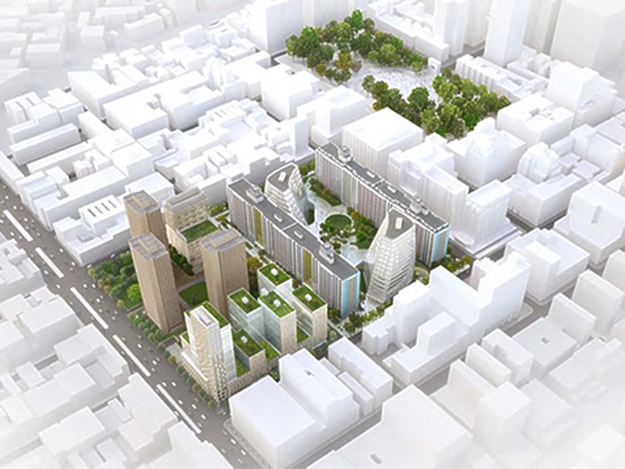The March 27 event drew roughly 200 attendees, many of them Greenwich Village residents opposed to the plan.
 |
| Image courtesy MAS |
|
NYU wants to add 2.5 million square feet to its Greenwich Village campus. The plan will likely reach the city council this summer. |
New York University has proposed reshaping its Greenwich Village neighborhood with 2.5 million square feet of new construction, dramatically increasing density on two “superblocks” devoted mainly to faculty housing. The plan, initially generated by a competition-winning team composed of SMWM (now part of Perkins+Will), Toshiko Mori, Grimshaw Architects, and Olin Partnership, would entail the demolition of several buildings. The controversial proposal is moving through the city’s labyrinthine approval process and is likely to reach the city council by June. Michael Kimmelman, the New York Times architecture critic, recently suggested a compromise that would green-light some of the new structures while declaring others—including a pair of boomerang-shaped towers— “non-starters.”
But at a debate last night attended by roughly 200 people, the audience members—many of them Village residents—seemed disinclined to compromise, and relieved that their representative, community board chairman Brad Hoylman, was taking a hard line. “In years of discussion, we have not had a single person who was unaffiliated with NYU support the expansion,” said Holyman flatly. NYU, he said, “has simply not made its case to the community.”
The debate, sponsored by the Municipal Art Society, effectively pitted Holyman against Hilary Ballon, the renowned architectural historian, who in 2007 left Columbia University for an administrative post at NYU (where her duties include creating a new campus in Abu Dhabi). The author of books on Robert Moses and Manhattan’s street grid, Ballon spoke out in favor of the big idea. “It’s essential for a thriving university to grow,” she told the audience. “If we don’t take steps now, we won’t be ready for the future.”
The other two debaters took more nuanced positions. “Get the massing right to start with: Once you block the light you can’t get it back,” advised Gary Hack, a professor emeritus of city and regional planning at the University of Pennsylvania. Ron Schiffman, a professor of planning at Pratt, said the kind of density NYU is proposing, by changing the nature of the Village, will be “self-defeating.”
Hoylman repeatedly noted that NYU has been vague about how it planned to use the new buildings, and he expressed incredulity that one of them is likely to contain a hotel. “Hotels don’t generally improve academic excellence,” he said. But Hack argued that a university that brings together students and faculty from around the world did, in fact, need hotel space to support academic programs.
The debate’s suave moderator, John Alschuler, a financier and Friends of the High Line board chair, made one misstep, suggesting that “nobody” would miss the Coles Sports Center, NYU’s bunker-like gym on Mercer Street that opened in 1981; under the proposed expansion plan, it would be razed. Audience members responded by shouting that what would be missed is “light and air”—two benefits conferred on neighbors by the low-slung building. Ballon tried to reassure audience members that their views mattered, saying, “Even though it may not feel this way all the time, the university does care deeply.”
Disclosure: The author of this story studied law at NYU.
Update 3/30/12: The current plan for NYU's expansion on two superblocks in Greenwich Village is the work of Grimshaw Architects, Toshiko Mori Architects, and Michael Van Valkenburgh Associates. In addition, Grimshaw is the lead architect on the two "boomerang" towers proposed for Washington Square Village.

Post a comment to this article
Report Abusive Comment